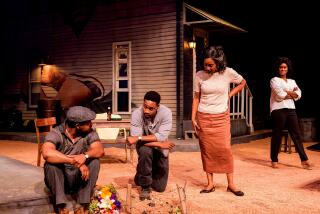Little Performance in Wilson’s ‘Informance’
- Share via
Bandleader-composer Gerald Wilson’s appearance in the Grand Hall of the Dorothy Chandler Pavilion Sunday afternoon was billed as a “Jazz Informance.” Subtitled “The Early Years: Ragtime to Swing, 1900-1940,” it was the first in a three-part history of jazz series presented by the Thelonious Monk Institute of Jazz at the Music Center.
“Informance,” according to the institute, describes a combination of “information” and “performance,” aimed at providing audiences with an “interactive” jazz experience. But Wilson’s presentation was long on information and short on performance. The program opened with an introductory blues number from his big band, which served to introduce many of the first-rate soloists in the ensemble. The overflow audience, filling two levels of the Grand Hall, responded enthusiastically, applauding each of the individual players as they took their turns in the spotlight.
That, however, was the last the audience heard from the musicians for the next hour. Wilson turned instead to recordings, essentially reprising, in miniature, the history of jazz lecture from his UCLA jazz program. And the string of recordings by Scott Joplin, Jelly Roll Morton, King Oliver, Louis Armstrong, Benny Goodman and others had some undeniably fascinating moments, illuminated by Wilson’s biographical information.
But it was difficult to understand why Wilson’s large, talented band was obliged to sit awkwardly on stage, not playing a note until the final 10 or 15 minutes of the program. Granting the historical value of the recordings that were played, the points Wilson was trying to make would have had a far greater impact had they been demonstrated by the live musicians.
Why not, for example, have the pianist do “The Entertainer” rather than play a recorded rendering of a Scott Joplin piano roll? Why not use small ensembles from the Wilson orchestra to depict New Orleans style or small swing band style rather than play more recordings? Why not use the entire orchestra to demonstrate big-band swing?
The presentation was further hampered by poor time management. By scheduling too many recorded segments, the production obliged Wilson to omit too much information, leaving out, for example, illustrations of Duke Ellington, Jimmy Lunceford or Fletcher Henderson, while including selections from three Benny Goodman ensembles.
The “Informance” concept is an intriguing approach by the Monk Institute/Music Center partnership to combine information with performance. But future installments--which include “Bebop to Hard Bop” (March 22) and “Contemporary Jazz” (April 26)--would do well to find a more equitable balance between the two elements.
More to Read
The biggest entertainment stories
Get our big stories about Hollywood, film, television, music, arts, culture and more right in your inbox as soon as they publish.
You may occasionally receive promotional content from the Los Angeles Times.










